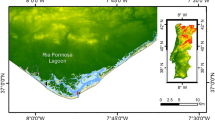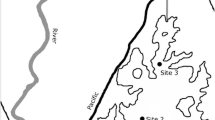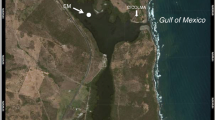Abstract
We studied the potential nutrient limitation of phytoplankton by means of seston nutrient stoichiometry and nutrient enrichment bioassays in the epilimnion of Lake Tanganyika. In most cases, the particulate carbon to phosphorus (C:P) ratio was high and indicated moderate P deficiency, while the respective C:N ratio mainly suggested moderate N deficiency. The N:P ratios of seston indicated rather balanced N and P supply. In three two-day enrichment bioassays in April–May 1995, a combined addition of P, N and organic carbon (glucose) always increased primary production in comparison to untreated controls. Primary production also slightly increased after the addition of phosphate-P, while the additions of single ammonium-N and glucose had no effect. Although the measured turnover time of P was short and our few nutrient enrichment experiments suggested that P may be the most limiting single nutrient, the particulate nutrient ratios and the strong stimulation of primary production after the combined addition of P and N mostly suggest that in the upper epilimnion of Lake Tanganyika plankton experience a restricted, but approximately balanced nutrient supply.
Similar content being viewed by others
References
Coulter, G. W. (ed.), 1991. Lake Tanganyika and its Life. Natural History Museum Publications, Oxford University Press, New York: 354 pp.
Currie, D. J. & J. Kalff, 1984. A comparison of the abilities of freshwater algae and bacteria to acquire and retain phosphorus. Limnol. Oceanogr. 29: 298–310.
Edmond, J. M., R. F. Stallard, H. Craig, V. Craig, R. F. Weiss & G. W. Coulter, 1993. Nutrient chemistry of the water column of Lake Tanganyika. Limnol. Oceanogr. 38: 725–738.
Elser, J. J. & B. L. Kimmel, 1986. Alteration of phytoplankton phosphorus status during enrichment experiments: implications for interpreting nutrient enrichment bioassay results. Hydrobiologia 133: 217–222.
Elser, J. J., E. R. Marzolf & C. R. Goldman, 1990. Phosphorus and nitrogen limitation of phytoplankton growth in the freshwaters of North America: a review and critique of experimental enrichments. Can. J. Fish. aquat. Sci. 47: 1468–1477.
Gerthart, D. Z. & G. E. Likens, 1975. Enrichment experiments for determining nutrient limitation: four methods compared. Limnol. Oceanogr. 20: 649–653.
Goldman, J. C., J. J. McCarthy & D. G. Peavey, 1979. Growth rate influence on the chemical composition of phytoplankton in oceanic waters. Nature 279: 210–215.
Goldman, J. C., 1980. Physiological processes, nutrient availability and the concept of relative growth rate in marine phytoplankton ecology. In P. Falkowski (ed.), Primary Production in the Sea. Plenum, New York: 179–194.
Harris, G. P., 1986. Phytoplankton ecology: structure, function and fluctuation. University Press, Cambridge: 384 pp.
Healey, F. P. & L. L. Hendzel, 1980. Physiological indicators of nutrient deficiency in lake phytoplankton. Can. J. Fish. aquat. Sci. 37: 442–453.
Hecky, R. E., 1991. The pelagic ecosystem. In G. W. Coulter (ed.), Lake Tanganyika and its Life. Natural History Museum Publications, Oxford University Press, New York: 90–110.
Hecky, R. E. & P. Kilham, 1988. Nutrient limitation of phytoplankton in freshwater and marine environments: A review of recent evidence on the effects of enrichment. Limnol. Oceanogr. 33: 796–822.
Hecky, R. E., R. H. Spigel & G. W. Coulter, 1991. The nutrient regime. In G. W. Coulter (ed.), Lake Tanganyika and its Life. Natural History Museum Publications, Oxford University Press, New York: 76–89.
Hecky, R. E., P. Campbell & L. L. Hendzel, 1993. The stoichiometry of carbon, nitrogen, and phosphorus in particulate matter of lakes and oceans. Limnol. Oceanogr. 38: 709–724.
Henry, R., K. Hino, J. G. Tundisi & J. S. B. Ribeiro, 1985. Responses of phytoplankton in Lake Jacaretinga to enrichment with nitrogen and phosphorus in concentrations similar to those of the River Solimões (Amazon, Brazil). Arch. Hydrobiol. 103: 453–477.
Kilham, P. & R. E. Hecky, 1988. Comparative ecology of marine and freshwater phytoplankton. Limnol. Oceanogr. 33: 776–795.
Koroleff, F., 1983. Simultaneous oxidation of nitrogen and phosphorus compounds by persulfate. In K. Grasshoff, M. Eberhardt & K. Kremling (eds), Methods of Seawater Analysis. Verlag Chemie, Weinheimer, Germany: 168–169.
Murphy, J. & J. P. Riley, 1962. A modified single solution method for the determination of phosphate in natural waters. Analyt. chim. Acta 27: 31–36.
Niemi, M., J. Kuparinen, A. Uusi-Rauva & K. Korhonen, 1983. Preparation of algal samples for liquid scintillation counting. Hydrobiologia 106: 149–156.
Redfield, A. C., 1958. The biological control of chemical factors in the environment. Am. Sci. 46: 205–222.
Riemann, B., R. Lignell & E. Laws, 1993. Time-course development of 14C specific activity of chlorophyll a, carbon and proteins in algal cultures. Limnol. Oceanogr. 38: 96–111.
Salonen, K., 1979. A versatile method for rapid and accurate determination of carbon by high temperature combustion. Limnol. Oceanogr. 24: 177–183.
Salonen, K., 1981. Rapid and precise determination of total inorganic and gaseous organic carbon in water. Wat. Res. 15: 403–406.
Salonen, K. & J. Sarvala, 1994. Sources of energy for secondary production in Lake Tanganyika. Objectives, approaches and initial experiences. FAO/FINNIDA Research for the Management of the Fisheries of Lake Tanganyika. GCP/RAF/271/FIN-TD/26 (En): 30 pp.
Schelske, C. L., E. F. Stoermer, G. L. Fahnenstiel & M. Haibach, 1986. Phosphorus enrichment, silica utilization and biogeochemical silica depletion in the Great Lakes. Can. J. Fish. aquat. Sci. 43: 407–415.
Schindler, D. W., R. V. Schmidt & R. A. Reid, 1972. Acidification and bubbling as an alternative to filtration in determining phytoplankton production by the 14C method. J. Fish. Res. Bd Can. 29: 1627–1631.
Steemann Nielsen, E., 1952. The use of radioactive carbon (14C) for measuring organic production in the sea. J. Cons. perm. int. Explor. Mer 18: 117–140.
Vadstein, O., Y. Olsen & H. Reinartsen, 1993. The role of planktonic bacteria in phosphorus cycling in lakes – sink and link. Limnol. Oceanogr. 38: 1539–1544.
Vuorinen, I., H. Kurki, E. Bosma, D. Chitamwebwa & A. Kalangali, 1995. Diel vertical migration (DVM) and distribution pattern of the pelagic copepoda of Lake Tanganyika. Kuopio University Publications C, Natural and Environmental Sciences 34: 49.
Author information
Authors and Affiliations
Rights and permissions
About this article
Cite this article
Järvinen, M., Salonen, K., Sarvala, J. et al. The stoichiometry of particulate nutrients in Lake Tanganyika – implications for nutrient limitation of phytoplankton. Hydrobiologia 407, 81–88 (1999). https://doi.org/10.1023/A:1003706002126
Issue Date:
DOI: https://doi.org/10.1023/A:1003706002126




